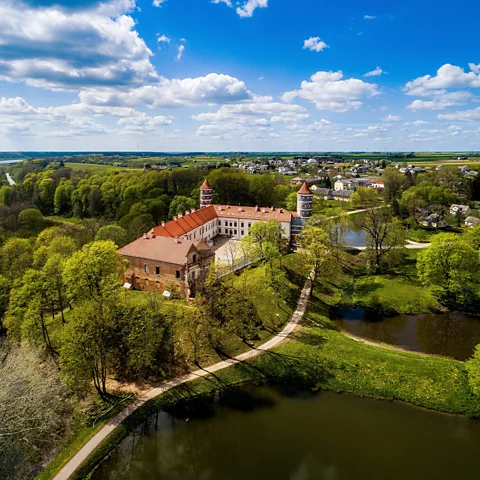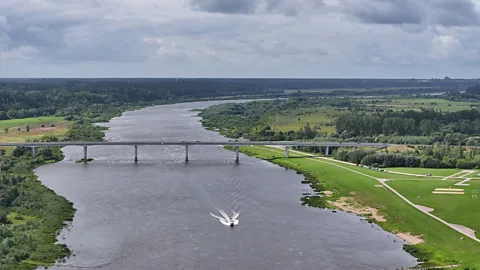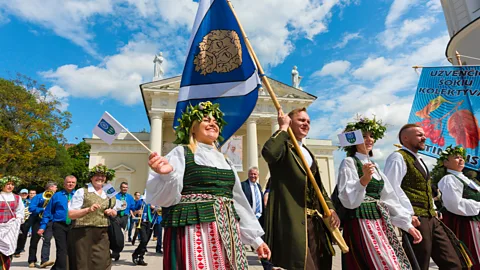Panemunė: The scenic road that saved Europe's banned language
 Lukas Pileckas
Lukas PileckasFor nearly 40 years, daring smugglers transported nearly 40,000 Lithuanian-language books into the nation each year when it was forbidden under Russian rule.
Following the gentle bends of the Nemunas, Lithuania's largest river, the Panemunė road stretches for more than 100km and marks the former border between Lithuania and East Prussia (now Kaliningrad, Russia). Considered the most romantic road in Lithuania by locals, it travels past a series of 17th-Century castles, Renaissance-era mansions and postcard-worthy towns.
Yet, the route is perhaps best known as the site of a remarkable movement that took place in the late 19th Century and helped save Lithuanian, which is commonly considered the world's oldest surviving Indo-European language.
Panemunė was built in the early 13th Century along a chain of early medieval fortresses and castles designed to protect the Grand duchy of Lithuania from the invading Teutonic forces coming from Prussia. By the 1800s, it had developed into a major trade and travel route as the fortresses became mansions for the nobility, and smaller towns grew around them.
Among the road's many regal attractions are the Castle of Panemunė, a 17th-Century manor complete with intricate frescoes and a park with cascading ponds that's been transformed into a lavish hotel and artist residence. Ten kilometres east of the castle, Raudone ("The Red Castle") is a 16th-Century fortress that was partially destroyed during World War Two but has since been rebuilt and now offers horseback riding, archery lessons and a weekly food and arts fair.
 Alamy
AlamyA further 20km east, the ancient city of Veliuona and the castle hill of Seredzius come into view, where a 30-minute hike up the wooden steps to the top of the lush green hill reveals sweeping views of the Nemunas river below. As the road unfurls in one final sweeping bend before the city of Kaunas, the towers of the Raudondvaris Castle emerge. Built where the Nemunas and Nevezis rivers meet, this sprawling 17th-Century estate now features a concert hall, labyrinth park, museum and a restaurant.
"The Panemunė road is often called the 'paradise road' in Lithuania: it boasts exceptional scenery, rich history and countless cultural experiences ranging from the [Honey Valley]; boat trips along River Nemunas; [and] local dandelion wine tastings; to art and history museums, food fairs and cultural events in the Renaissance mansions along the road," said Eglė Speičienė, founder of the local travel agency TavoGidas. Because of the many castles, rolling hills and boutique wineries located along the Panemunė, Speičienė says some travellers liken the road to France's famed Loire Valley.
However, stunning scenery and dreamy castles aren't the only thing Panemunė is known for. The road is also where a unique Lithuanian movement took place in the late 19th Century that would help shape the nation's character: book smuggling.
From 1865 to 1904, the Lithuanian language (which is actually related to ancient Sanskrit and diverged thousands of years ago) was banned under the tsarist Russian rule, which controlled large swathes of the country at the time. The ban prohibited the printing, possessing and distributing of any publications in Lithuanian with the Latin alphabet – but instead of creating a complete Russification of the country, it had the opposite effect.
 Alamy
AlamyA large network of resistance publishers, book smugglers and distributors sprang up and more than three million books, scientific papers, textbooks and newspapers were printed in Lithuanian in East Prussia and the US, which each had large populations of Lithuanian émigrés. According to historian Vytautas Merkys, during this 39-year-period more than 40,000 Lithuanian-language publications were smuggled into the country each year, reaching villages, parishes and towns across the nation via the Panemunė road.
Panemunė's proximity to both East Prussia and Poland, (where the books entered) helped it serve as an entry point into the nation for book-smugglers. Tilžė (now Sovetsk, Kaliningrad) was one of the main points where smugglers crossed, and the road's final point, the city of Kaunas, served as Lithuania's capital from 1919 to 1940 and was a centre for cultural resistance against the Russians.
"Essentially, Panemunė was the main artery through which the Lithuanian printed press and books reached the country. River Nemunas was a crucial point for crossing into the country. Some book smugglers swam across, carrying bundled-up books on their bodies, while some transported books hidden in steamboats or paid merchants to help," explained Vaidas Banys, a historian and educator. "[These] banned books, newspapers and religious texts reached deep into the country."
According to Banys, these book smugglers were key to saving the Lithuanian language. They frequently carried up to 80lbs of printed Lithuanian books and other publications, smuggling them from East Prussia and other border locations across the Nemunas river, then transporting them along the backroads of Panemunė in horse-drawn carts hidden among stacks of hay, furniture or even empty coffins.
 Lukas Pileckas
Lukas Pileckas"All routes were intricately connected, and no book smuggler worked alone. It wasn't just the person who smuggled the books across the border or carried them on their bodies. There were people who would carry the printed materials for a leg of the way, further distribute the prohibited press, finance the printing or supply local communities, parishes and schools," Banys said. "There [wasn't] a 'typical' book smuggler profile, either: people involved in the printing and transporting of the books came from all backgrounds – from simple peasants and devout women to landowners, priests, merchants, bankers and doctors. The network spanned thousands of individuals and organisations. That, in the end, was why the Russians eventually gave up and lifted the ban – the network was so vast and well-connected that it was impossible to destroy."
According to Banys, crossing the border was the most dangerous part of the journey. If caught, book smugglers could be shot on sight by Russian officials, imprisoned, tortured and banished to Siberia.
"A book smuggler had to know the smallest details – when the border guards would be changing, which ones could be bribed, which trails or river crossings were watched more closely. Even inside the country, they had to be careful who to trust, how to transport the books and press – using double floors in carts and boxes, paying Jewish merchants aboard the Nemunas steamboats, hiding the books under haystacks and merchandise," Banys added. "The severity of the punishment, when caught, also depended on the kind of books they carried: religious materials were considered less of an offense, and a book smuggler might get away with a fine or a few years of imprisonment. Newspapers and literature that promoted the ideas of freedom, democracy, Lithuanian national identity and the like usually carried a death sentence or deportation to Siberia."
According to Banys, these book smugglers didn't just save the language – they helped solidify Lithuanian identity, and, ultimately, its battle for independence.
 Alamy
Alamy"Although many of the fates of the book smugglers were tragic, their contribution and their memory remain vital. During the years of the language ban, one book smuggler from Kėdainiai was caught by the Russian officers and beaten so severely he went mad. Even when the ban was lifted, this man would still wander around with books on his back, and people would tell their kids: look what our language has cost us; study it and cherish it," Banys said.
When the Lithuanian language ban was lifted in 1904, Juozas Masiulis, one of the prominent book smugglers, opened his own book store in the town of Panevezys. The shop is now Lithuania's oldest bookstore. It's still operational today, and every year on 16 March, the nation commemorates the Day of the Book Smugglers.
The river ferry near Vilkija – the only remaining Nemunas ferry – is now a popular attraction along the Panemunė road, and travellers can experience what it must have been like to cross the river on smaller boats. In Kaunas, the final stop along the Panemunė road, visitors can also see the Wall of the Book Smugglers – a monument honouring those who perished on their perilous journeys.
Today, this scenic drive lives on as a living testament to Lithuania's rich culture, complex history and defiant spirit.
--
If you liked this story, sign up for The Essential List newsletter – a handpicked selection of features, videos and can't-miss news, delivered to your inbox twice a week.
